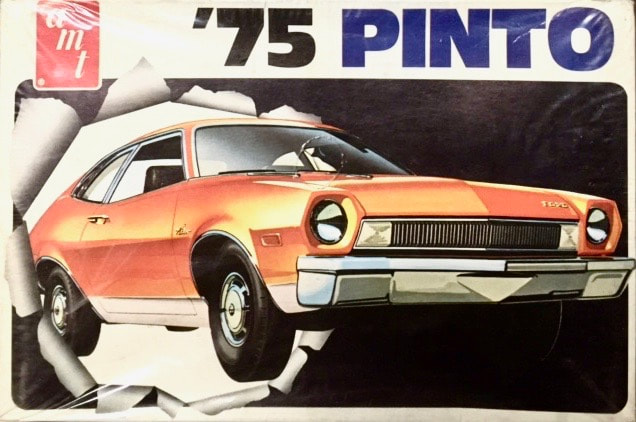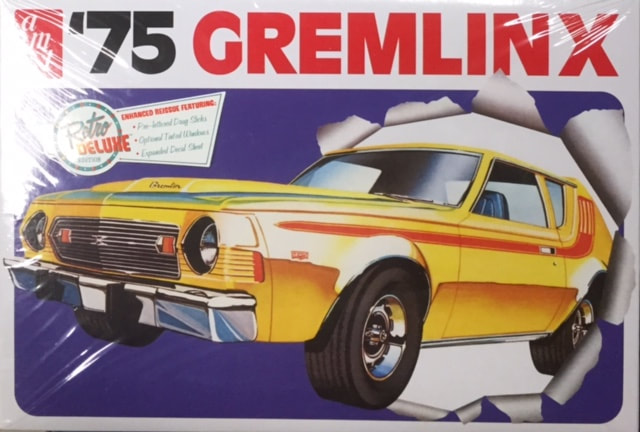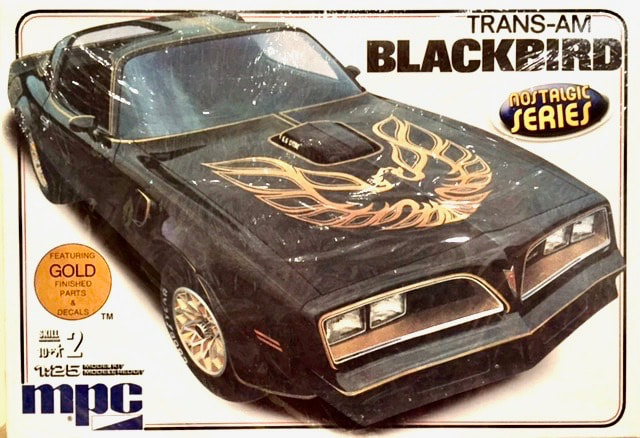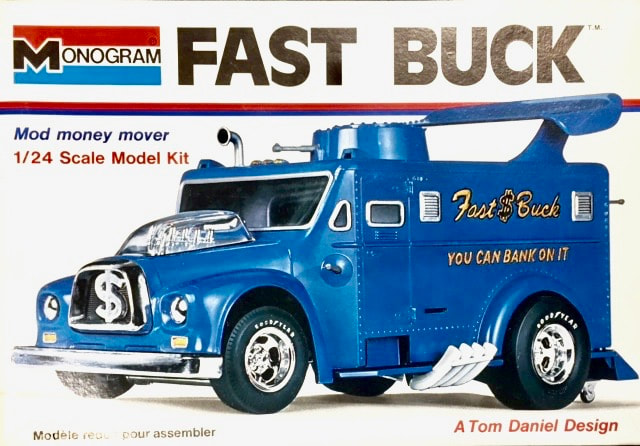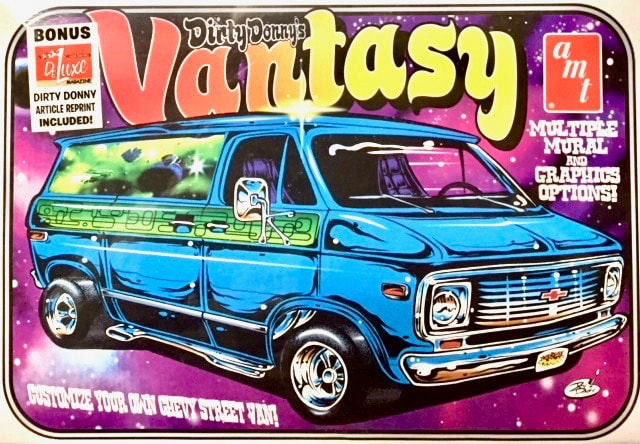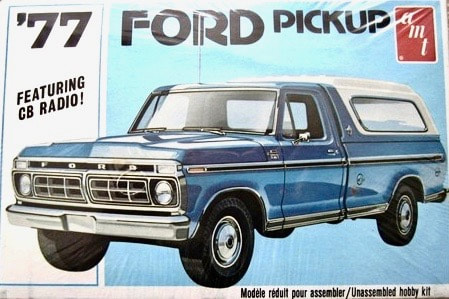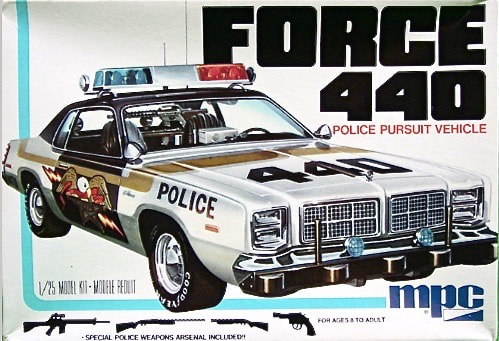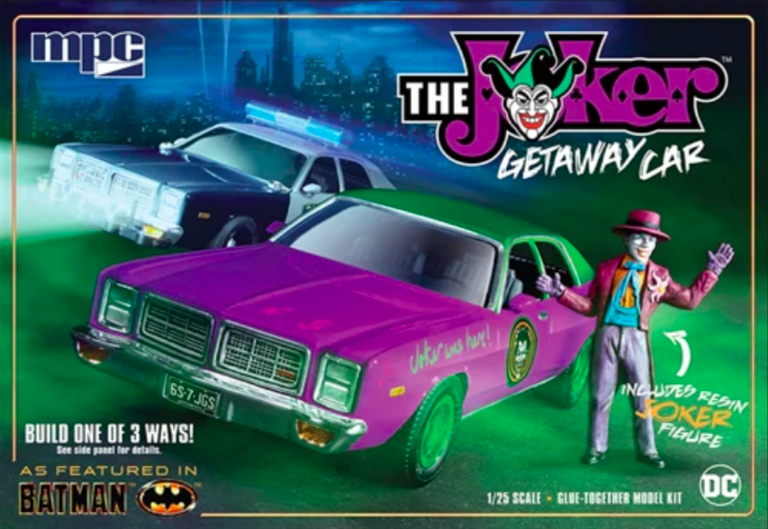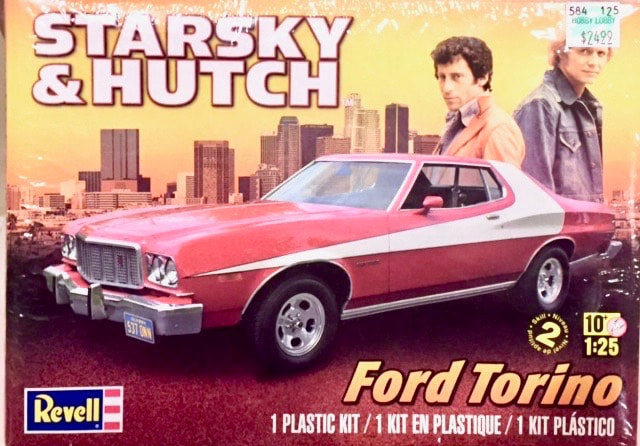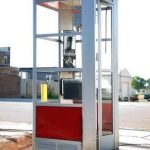|
This kit pretty much sums up car model building in the 1970’s. I’d classify the full-sized car’s ability to break through dry paper as false advertising thanks to the rather pitiful 2.3 liter engine in those things. And, I’m lucky to be alive after my Pinto was rear-ended. Thankfully, I wasn’t in it at the time.
|
However, going to all that trouble ignored one fact: Car models of the 1970’s kinda stunk. Tire-melting horsepower in real cars evaporated by mid-decade thanks to new fuel economy and emissions restrictions and in 1973, new federal laws were enforced for the five-mile-an-hour bumper (intended to protect the car from damage in an accident at five miles an hour or less). This “innovation” delighted the insurance industry and made most cars look like they had railroad ties hastily stuck on the ends.
And how about that V-8 engine in the all-new 1974 Mustang II? Oh wait–the Mustang, Ford’s iconic Pony Car–had NO V-8 engine that year. The Chevy Chevette and Vega could also be purchased as kits as well as AMC Gremlins and Pacers. Ironically, the Gremlin was probably the most fun of those cars to drive. Does anybody miss having the others in your driveway? Anyone? Anyone? Buhler? Buhler? (Oops–there’s a 1980’s reference–sorry!). |
|
There must be hundreds of 1960’s car model subjects available today. What about the 1970’s? Today, modelers who want to build “Me-Decade” cars don’t have as many choices. Not considering cars like the 1970 Barracuda and Challenger, which can be lumped with the 1960’s muscle car era, things are pretty lean. Another couple exceptions are the second-generation Firebirds and Camaros, which have had kits easily available since the 1990’s. The Chevy Corvette was likewise available in kit form all decade. The third generation ‘Vette soldiered along with the same innards from 1968 to 1983 and surprisingly, its federally-mandated bumper was somehow hidden inside the curvaceous form without too much obtrusiveness. 1/1 scale Corvette owners today find that the chrome-bumpered Corvettes made prior to 1973 have a higher collector value than the cars from 1973-on. It was no coincidence that the older cars had more horsepower.
|
Crazy Trivia Fact: AMC Motors kept poor records regarding the manufacturing of their cars. So purchasers of full-size vintage AMC cars such as the collectible AMX and Javelin have to be very wary of any “Numbers Matching” claims since no numbers were recorded to match ordered options to VIN numbers.
|
|
Why did the 1980 MPC kit catalog declare this kit “The Most Popular MPC kit ever made”? Stay tuned. You’ll learn in a future installment.
|
Fast Buck debuted in 1973. Check out that exciting plain-white background for the box art. This kit is a mid-1990’s re-release. Revell/Monogram re-released it again just recently in its silver guise as “Jinx Express,” the original version of Tom Daniel’s armored car fantasy rod. If scaled up from stated 1/24 scale, the real thing would be about the same size as a PT Cruiser.
|
|
Yet another trivia fact: Artist “Dirty Donny” Gillies is a 1974 model—born March 4 of that year.
|
Another cultural phenomenon during the 1970’s was custom vans. If you couldn’t have a vehicle with blistering speed, why not take all the comforts of home on the road or at least everything needed to tune in, turn on, and drop out. The coolest custom vans had a waterbed, lava lamp, shag carpet, and a sound system with an 8-track cartridge tape player eating a Doobie Brothers tape like Marlon Brando sucking down a spaghetti dinner. Groovy threads like bellbottom pants and a wild-pattern shirt with wide lapels and afro-style hair were a must to complete this vibe.
MPC and AMT sold a handful of van kits for the first time in the 1970’s. Like the car kits, the van models included custom options that were featured on the side of the box to entice kids to part with their paper route money. Hey–it worked for me. |
|
Otherwise utilitarian pickup trucks also were made into model kits later in the 1970’s. With some customization, wild 4X4’s could be constructed, or cool street cruisers. I bought a just-released AMT 1977 Ford F-series pickup and weathered mine with “mud” (sand stuck right on the model with tube glue and painted tan—absolutely dreadful). As it was getting on in the decade, I recall dispatching that one spectacularly. I don’t remember the specific method, but the mushroom cloud at the end left a lasting impression.
AMT recently released the 1978 version of their Ford F-series truck kit with a 4X4 chassis. The 1977 version, pretty much the same except with round headlights, still sells for big bucks (well over $100) on eBay today. What does that tell you about the popularity of these kits—then and now. |
More false advertising? Circa 2019, an asterisk statement would probably be required stating that the CB radio in the box did not actually work to protect the extremely dim-witted from major disappointment
|
In the late 1970’s, it seemed that every model car kit came with a CB radio! In 1/25 scale, the tiny chip of plastic was barely recognizable as such. Not only did the sides of model kit boxes proclaim this must-have accessory (which, by the way, was not included from the factory with the real cars), but the box tops usually proclaimed, “Includes CB Radio!” A whip antenna was also in there somewhere on the chrome sprue. It always got in the way and broke off the model. Seeing a kit nowadays with a CB radio brings back memories but doesn’t thrill me like a kit that includes an optional big-block motor, multiple 4-barrel carbs, and headers.
|
Current releases of this kit (Joker Getaway Car) have four doors and a oval cross-section light bar. Note that cop-issue bumper guard (still present in latest issues of the kit!). All it does on the real thing is protect the chrome finish on the battering ram disguised as the federally-mandated five-mile-an-hour-bumper
|
If you are in a mood to build a four-door barn-sided, railroad-tie bumper 70’s car, your ticket is the 1977-78 Dodge Monaco. Going way back, it was known as the “Force 440” police car when MPC first released it. Besides coming with more police goodies than you can imagine (SIX guns just for starters) it has at least one CB radio.
The kit had a versatile run as Rosco’s (Dukes of Hazzard) Police Car, TJ Hooker (AKA Captain Kirk)’s Police Car, and Batman’s Police Car. Actually in that incarnation, the boxtop proclaimed, “Joker Goon Car.” This is high on the list for my favorite-model-kit-names-ever. Even though none of the crazy-clown purple and green goon cars in the 1989 Batman movie were Dodge Monacos, AMT hoped we wouldn’t notice. For those modelers savvy to this, the kit included decals for a Gotham City police cruiser. |
|
“The Joker Getaway Car” doesn’t have the same ring as “Joker Goon Car.” However, Round2 doesn’t re-release a kit without providing a good incentive for owners of previous issues to buy the new one–this kit features a new Joker resin figure.
|
The most recent release of this kit, which is still very easy to find in hobby stores, is now known as the “Joker Getaway Car.” I was a little disappointed to see the “Goon” designation dropped. The box proclaims “As featured in Batman” with the 1989 movie logotype even though it was not.
1970’s Ford fans will recall the 1972 Torino being a beautiful car. It had that aggressive front clip that fit the nice lines on the rest of the car. When the 5-mile-an-hour bumper law went into effect for 1973, Ford had to seriously mess up the front end of the Torino. The front end that year is downright homely compared to the previous year in my humble opinion. This vintage of Torino probably would have faded into oblivion were it not for the 1975 TV buddy-cop show, Starsky and Hutch. |
|
There aren’t too many plank-bumpered 1970’s cars around as model kits these days, but Revell decided to buck the trend in 2015 by actually tooling up an awesome kit of a “Starsky and Hutch” Ford Torino. In addition to that beautifully executed, loathsome five-mile-an-hour bumper, the kit has a full engine. Parts count is pretty low, but what’s there should be detailed enough for discriminating modelers. So Revell took the lets-make-everybody-happy route with a kit molded in color that novices can build easily and experienced modelers can detail the heck out of it. Just add your favorite glue and don’t forget to grow a set of lambchop sideburns. Do it! Do it!
|
This is seriously a marvelous kit. The only thing missing is 1970’s-style box art.
|
